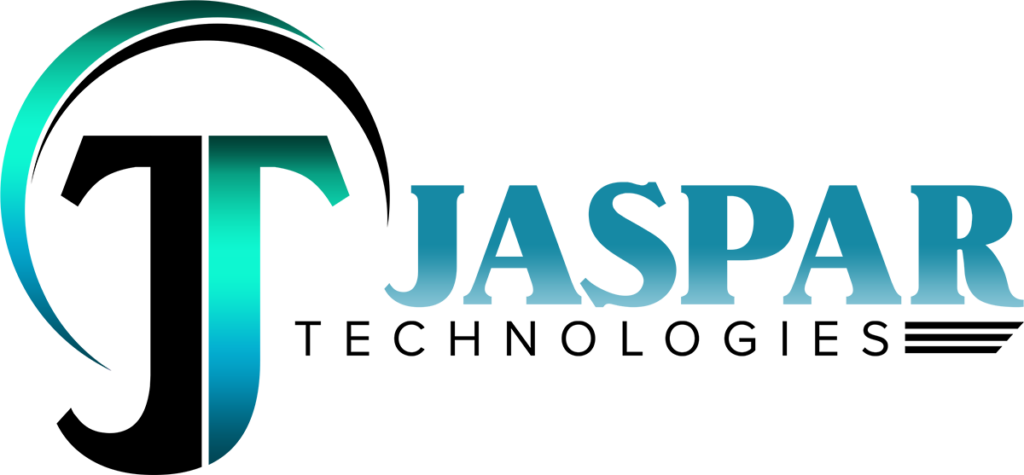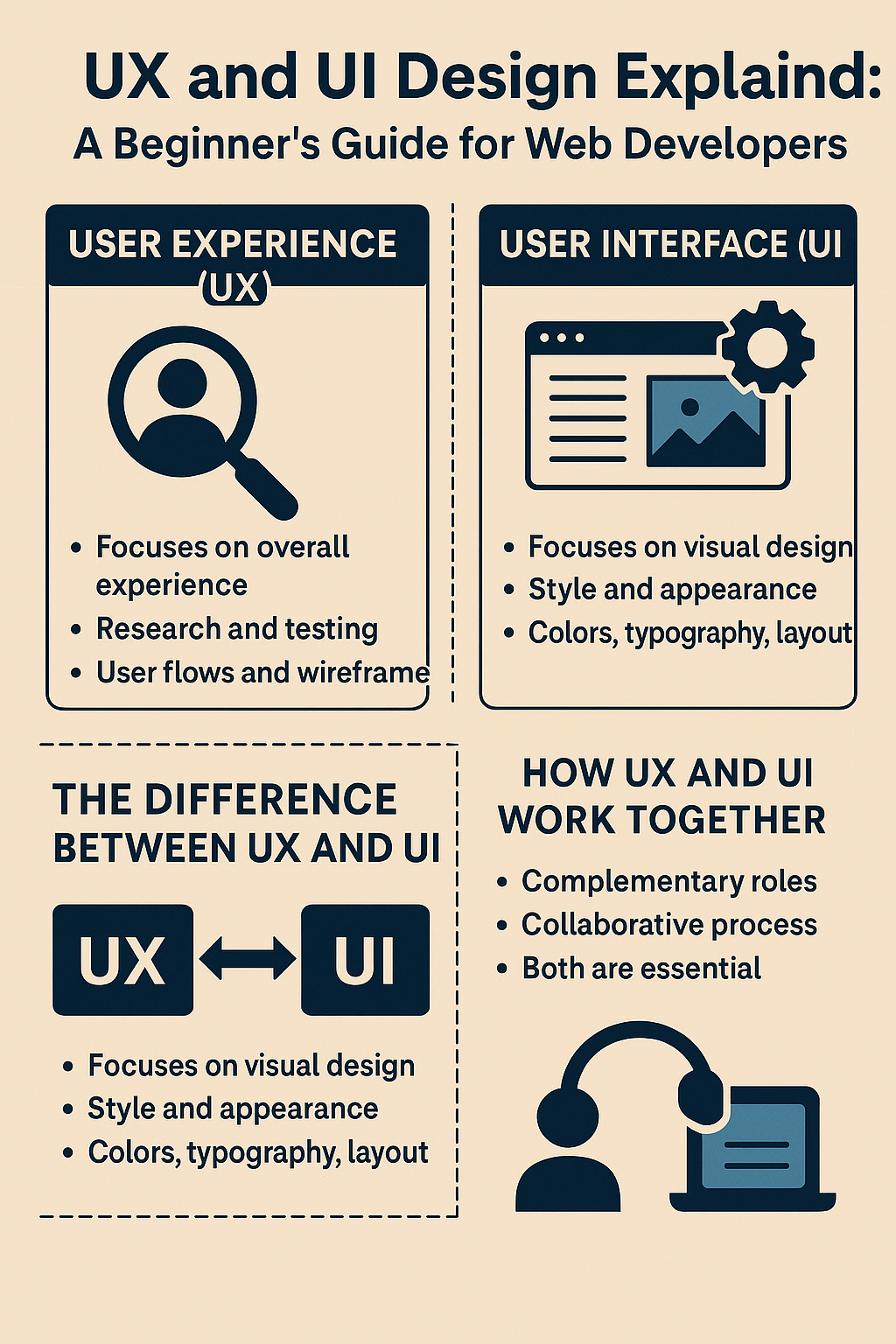Introduction
If you’re stepping into the world of web development, you’ve likely encountered the terms UX (User Experience) and UI (User Interface) design. While they might seem interchangeable, they represent distinct aspects of the design process, each crucial for creating effective digital products.
UX design focuses on the overall experience a user has with a product, ensuring it’s intuitive, efficient, and satisfying. It encompasses research, user flows, and testing to optimize how users interact with a system. UI design, on the other hand, deals with the visual and interactive elements—buttons, icons, spacing, typography—that users engage with directly.
Understanding the synergy between UX and UI is essential for web developers aiming to build user-centric websites and applications. This guide will delve into the definitions, differences, and collaborative nature of UX and UI design, providing you with a comprehensive foundation to enhance your development projects.
Table of Contents
- What Is UX and UI Design?
- The Difference Between UX and UI
- Why UX and UI Matter in Web Development
- Core Principles of UX Design
- Core Principles of UI Design
- The UX Design Process
- The UI Design Process
- Tools for UX and UI Design
- Common UX and UI Mistakes to Avoid
- Case Studies: Successful UX/UI Implementations
- Integrating UX/UI in Agile Development
- Accessibility in UX and UI Design
- The Future of UX and UI Design
- Learning Resources for Beginners
- Conclusion
What Is UX and UI Design?
User Experience (UX) Design is the process of enhancing user satisfaction by improving the usability, accessibility, and pleasure provided in the interaction between the user and the product. It involves understanding user behaviors, needs, and motivations through research and analysis.
User Interface (UI) Design focuses on the look and feel of the product—the visual elements that users interact with. This includes layout, color schemes, typography, and interactive elements like buttons and sliders.
While UX is about the overall experience, UI is about the specific elements that facilitate that experience.
The Difference Between UX and UI
Understanding the distinction between UX and UI is crucial:
- UX Design is about the overall feel of the experience. It’s the process of developing and improving the quality of interaction between a user and all facets of a company.
- UI Design is about how the product’s interfaces look and function. It’s the process of visually guiding the user through a product’s interface via interactive elements and across all platforms.
In essence, UX design is more analytical and technical, while UI design is closer to graphic design, though the responsibilities are more complex.
Why UX and UI Matter in Web Development
In web development, integrating UX and UI design principles is vital for creating products that are not only functional but also user-friendly and aesthetically pleasing. Good UX/UI design can lead to:
- Increased user engagement
- Higher conversion rates
- Improved customer satisfaction
- Enhanced brand reputation
Neglecting UX/UI can result in user frustration, increased bounce rates, and ultimately, loss of revenue.
Core Principles of UX Design
- User-Centric Design: Prioritize the needs and preferences of the user.
- Consistency: Maintain uniformity across the product to avoid confusion.
- Feedback: Provide users with clear feedback on their actions.
- Accessibility: Ensure the product is usable by people with various abilities.
- Usability: Design products that are easy to use and understand.
Core Principles of UI Design
- Clarity: Design interfaces that are easy to understand.
- Consistency: Use uniform elements to reduce the learning curve.
- Aesthetics: Create visually appealing designs that enhance user satisfaction.
- Responsiveness: Ensure the interface works well on various devices and screen sizes.
- Feedback: Offer visual cues to indicate interactions.
The UX Design Process
- Research: Understand the target audience through surveys, interviews, and analytics.
- Personas: Create fictional characters representing user types.
- User Flows: Map out the steps users take to complete tasks.
- Wireframing: Develop skeletal frameworks of the product.
- Prototyping: Build interactive models for testing.
- Testing: Conduct usability tests to gather feedback and iterate.
The UI Design Process
- Design Brief: Understand the project’s goals and requirements.
- Mood Boards: Compile visual inspirations to set the tone.
- Style Guides: Define typography, color schemes, and design patterns.
- High-Fidelity Mockups: Create detailed designs of the interface.
- Interactive Prototypes: Develop clickable models for user testing.
- Handoff: Provide developers with the necessary assets and specifications.
Tools for UX and UI Design
- Figma: Collaborative interface design tool.
- Sketch: Vector graphics editor for macOS.
- Adobe XD: UI/UX design and collaboration tool.
- InVision: Digital product design platform.
- Axure RP: Wireframing and prototyping tool.
- Balsamiq: Rapid wireframing tool.
Common UX and UI Mistakes to Avoid
- Overcomplicating Navigation: Keep menus and navigation intuitive.
- Ignoring Mobile Users: Design with a mobile-first approach.
- Inconsistent Design Elements: Maintain uniformity in design components.
- Lack of User Testing: Regularly test designs with real users.
- Neglecting Accessibility: Ensure designs are inclusive for all users.
Case Studies: Successful UX/UI Implementations
- Airbnb: Simplified booking process with intuitive UI.
- Spotify: Personalized user experiences through UX research.
- Dropbox: Clean UI with straightforward user flows.
These companies have invested heavily in UX/UI design, resulting in increased user satisfaction and business growth.
Integrating UX/UI in Agile Development
In Agile methodologies, UX/UI designers work closely with developers in iterative cycles. This collaboration ensures that user feedback is incorporated continuously, leading to products that better meet user needs.
Accessibility in UX and UI Design
Designing for accessibility means creating products usable by people with disabilities. This includes:
- Using sufficient color contrast
- Providing text alternatives for images
- Ensuring keyboard navigability
- Designing for screen readers
Adhering to accessibility standards not only broadens your audience but also enhances overall user experience.
The Future of UX and UI Design
Emerging trends shaping the future of UX/UI include:
- Voice User Interfaces (VUIs): Designing for voice-activated systems.
- Augmented Reality (AR): Integrating digital elements into the real world.
- Artificial Intelligence (AI): Personalizing user experiences.
- Micro-Interactions: Enhancing user engagement through subtle animations.
Staying abreast of these trends will be crucial for future-ready designs.
Learning Resources for Beginners
- Online Courses:
- Coursera: UI/UX Design Specialization
- Udemy: User Experience Design Essentials
- Books:
- Don’t Make Me Think by Steve Krug
- The Design of Everyday Things by Don Norman
- Communities:
Engaging with these resources can accelerate your learning and provide practical insights.
Conclusion
Understanding and applying UX and UI design principles is essential for web developers aiming to create user-friendly and effective digital products. By focusing on the user’s needs and ensuring intuitive, aesthetically pleasing interfaces, you can enhance user satisfaction and achieve your project’s goals.
FAQs
Q1: What is the main difference between UX and UI design?
A1: UX design focuses on the overall user experience and how users interact with a product, while UI design concentrates on the visual and interactive elements that facilitate that experience.
Q2: Can a web developer also be a UX/UI designer?
A2: Yes, many web developers acquire UX/UI design skills to create more user-centric products. However, each role requires specific expertise and continuous learning.
Q3: What tools are recommended for beginners in UX/UI design?
A3: Tools like Figma, Adobe XD, and Balsamiq are user-friendly and widely used in the industry, making them great choices for beginners.
Q4: How important is user testing in UX design?
A4: User testing is crucial as it provides insights into how real users interact with your product, allowing you to make informed improvements.
Q5: What is responsive design, and why is it important?
A5: Responsive design ensures that a website or application functions well on various devices and screen sizes, providing a consistent user experience across platforms.
Share Your Thoughts
We hope this guide has clarified the concepts of UX and UI design for you. Which aspect do you find most intriguing or challenging? Share your thoughts and experiences in the comments below. If you found this article helpful, feel free to share it with your network!



